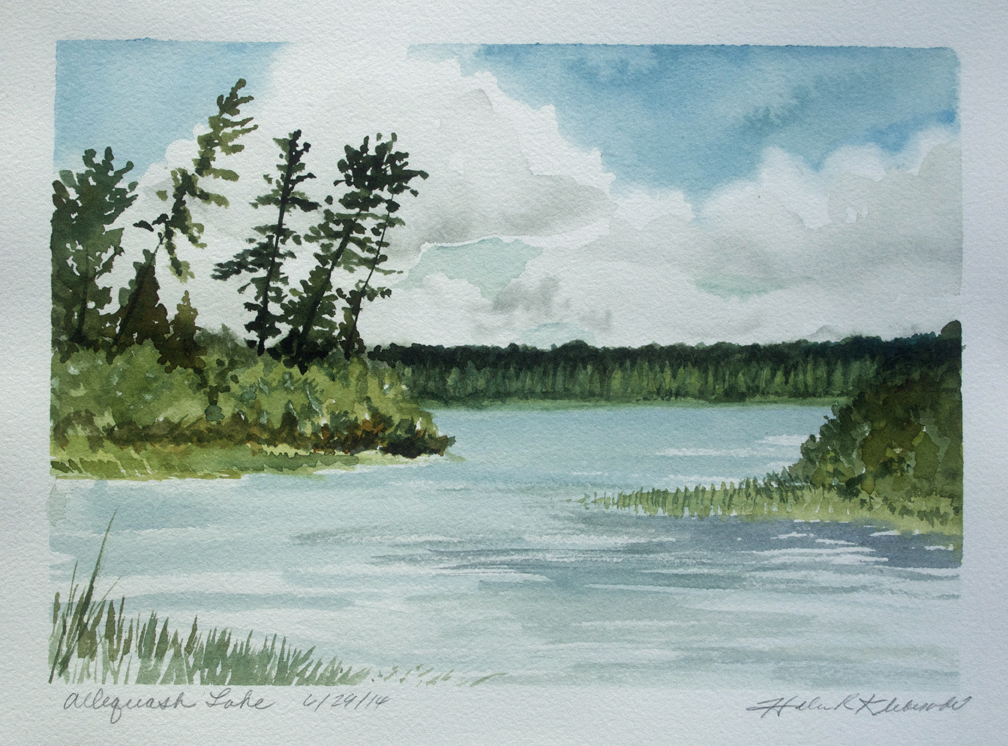
Allequash Lake, plein air painted watercolor by Helen Klebesadel, near Boulder Junction, WI, June 2014
I have just returned from a splendid ten days of non-stop plein air painting (and skitter swatting) in the lake country around Boulder Junction, Wisconsin. It was my extreme pleasure to bring my art research through observation to the University of Wisconsin Trout Lake Station as a part of a new artist residency program. I was given a space to stay and access to a canoe and the researchers working this summer at the Station. The Trout Lake Station is a year-round field station operated by the Center for Limnology at the University of Wisconsin-Madison. Located in the Northern Highland Lake District in northern Wisconsin, the station provides access to a wide variety of aquatic ecosystems and their surrounding landscapes. More than 2500 lakes are within 50km of the station.
The Trout Lake Station is a field site of the North Temperate Lakes Long Term Ecological Research (LTER) project, which is part of a national network studying long-term ecological change. The residency is designed for visual artists, writers and musicians who have specific interests in exploring the relationship between people, northern lakes and landscapes, and the long-term scientific investigations of the LTER project. One 1-2 week residency between June 1 and August 31 will be offered each year. (Keep an eye out for the next call for applications in the fall. I will post it on my Art Face Book page.)
My thanks to Trout Lake Research Station Director, Tim K. Kratz , who made me feel so welcome, and to freelance artist and field biologist, Terry Daulton, who was both a guide and an inspiration. Both Tim and Terry have been involved in actively imagining how the arts and humanities can become a part of the long terms reflections and research being done at Trout Lake Research Station.
The Artist-in-Residency program is a part of the larger Ecological Reflections that is a network of sites dedicated to long-term, collaborative science and art inquiry in places of ecological or cultural importance. The network grew from the NSF funded Long-Term Ecological Research (LTER) program. Outreach efforts at more than a dozen of the twenty-six LTER sites have developed programs that foster collaborations among the sciences, arts, and humanities.
Sites represented in the Ecological Reflections network extend from the hardwood forests of New England to the old growth forests of the Oregon Cascades; from the fresh and saltwater wetlands of the Everglades to the temperate lakes of Northern Wisconsin. The creative responses cultivated through the network mirror the diverse scientific, artistic, and cultural facets and legacies of these places.
After several years of imagining and planning the University of Wisconsin Trout Lake Station ‘Artist in Residency’ was launched in 2013. The first artist-in-residence in 2013 was Ann Singsaas. I am happy to have been selected as the second artist-in-residence. The goal of this artist-in-residency program is to create collaborative art/humanities and science projects focusing on the long-term ecology of lakes and their surrounding landscapes in Vilas County, Wisconsin.
My goals for the residency initially were to capture a bit of the sense of what its like to do lake research by looking at the tools of the trade, as well as to visit and paint in watercolor my own reflections on and responses to as many of the sites that are the focus of the Trout Lake researchers as my time there would allow. I made it to five of the seven main research subjects, but I could have painted any one lake or blog repeatedly during my ten working days there and still not have truly captures the beauty and dynamism of the places.
The North Temperate Lakes Long Term Ecological Research (LTER) program studies the ecology of lakes as one of a network of sites established by the National Science Foundation to support research on long-term ecological phenomena. They are interested in how biophysical setting, climate, and changing land use and cover interact to shape lake characteristics and dynamics over time (past, present, future). Their primary study sites include a set of seven northern Wisconsin and four southern Wisconsin lakes and their surrounding landscapes. The project, which started in 1981, is administered by the Center for Limnology at the University of Wisconsin-Madison.
Ecological Reflections is a network of sites dedicated to long-term, collaborative science and art inquiry in places of ecological or cultural importance. The network grew from the NSF funded Long-Term Ecological Research (LTER) program. Outreach efforts at more than a dozen of the twenty-six LTER sites have developed programs that foster collaborations among the sciences, arts, and humanities. In recent years the National Science Foundation provided the Trout Lake Station with seed funding to initiate an arts and science collaboration titled LTEArts. This effort created three earlier traveling art/science exhibits and the web site for the exhibition Drawing Water.
Artist Terry Daulton has been instrumental in many of these art/science projects. Her wonderful pastel paintings reflect her deep ties to the landscape and her background as a biologist and environmental educator. Terry and her husband, Jeff Wilson, live in small log cabin on a remote island in Wisconsin’s Turtle Flambeau Flowage. Her paintings chronicle their life on the flowage and other Northwood’s haunts.
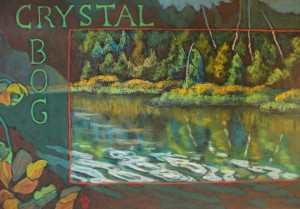
Crystal Bog, 19×27, pastel, 2012, by Terry Daulton. This is a piece was created for the Ecological Reflections show at National Science Foundation
In 2006 Terry created art for and curated the art/science education exhibit called “Paradise Lost? Climate Change in the Northwoods” which I participated in. It involved 20 artists and 6 scientists. Paradise Lost? was seen by over 100,000 visitors in the Upper Midwest.
Building on that project she began a longer term collaboration with the University of Wisconsin – Center for Limnology and the North Temperate Lakes Long Term Ecological Research Project. In this collaboration, she is working with scientists to bring the arts and sciences together in a public education campaign. Their first project was “Drawing Water: Artists and Scientists Explore Northern Lakes”.
This exhibition grew out of the question “What happens when six artists and six scientists join in exploring the complexity, beauty and future of northern lakes?” The participants were determined to combine the insights of artists and scientists to create something extraordinary: to visualize life below the surface, to travel backward and forward through time, to anticipate our future. The exhibit invites viewers to enter a realm where abstract thought, imagination and vision meld with the scientific world. You can see a slide show of some of this work here.
The goals of all of these art projects like the artist-in residency are to:
- create new ways to share research and information with the public,
- create a long term record of arts and humanities responses to the lake landscapes in our region
- foster deeper collaborations between scientists and artists
I’m suspect that I was selected to be given this experience because , as I mentioned earlier, I was lucky enough to be a part of an earlier arts/science collaboration in 2006 called Paradise Lost?: Climate Change in the North Woods, in which 20 artists, 7 scientists and 6 educators met in a boy scout camp in May to learn about climate change and the potential role of art in increasing public awareness of science. I and the other 19 artists subsequently created pieces including paintings, sculpture, poetry and music reflecting our perceptions of the science of climate change, its impacts on northern ecosystems and the actions that can be taken now to lessen those impacts. An exhibition of this work traveled throughout the region for three years. A downloadable catalog is available on the website.
My watercolor for the project, Winter’s End, focused on the flora and fauna that are cold weather dependent and likely to move north in as the Wisconsin climate warms.
The science educators created a dynamic website out of the work we did. It has been built to link concepts, activities, videos, art and science together for K-12 teachers to aid in teaching about climate change. You can check out Paradise Lost?: Teaching Climate Change in the Great Lakes Region
THE RESEARCH
I met many of the researchers, graduate students and undergraduates who are there for all or part of the summer, and learned a bit about the kinds of long-term research being done, which includes but is not limited to:
Lake Level Monitoring by Citizen Scientists: Carl Watras and Noah Lottig are monitoring groundwater and lake water levels in Wisconsin Northern Highlands region, which have reached record low levels in the last decade. Because there was no existing mechanism for monitoring long-term trends, they established a lake-level monitoring network comprised of citizen scientists in collaboration with the Wisconsin Department of Natural Resources, United States Geological Survey, and the North Lakeland Discovery Center. Data was first collected in 2008 and the network has been expanding since. They are also now crowdsourcing water levels at several lakes using installations that provide instructions for any individual to text them current water levels. These data appear in near real-time on www.lakechange.org.
Carl also heads up the Sentinel Lakes Project: responses to acid rain, mercury rain and climate change, which tracks the response of lakes to atmospheric contaminants, like mercury deposition and acid rain, as well as the compounding effects of climate change on water budgets
Researcher Susan Knight is doing a Field Test on the Effectiveness of Milfoil Weevil for Controlling Eurasian Water-Milfoil in Northern Lakes. The Eurasian water-milfoil (EWM) is a nuisance aquatic plant growing in an increasing number of Wisconsin lakes, and some prior research has shown that the water-milfoil weevil, Euhrychiopsis lecontei, can significantly reduce densities. Through this research they hope to determine whether there is reason for the Wisconsin DNR to adopt augmentation with native weevils as an option to control EWM.
Another project underway that seeks to fight invasive species is the Crystal Lake Mixing Project. Rainbow smelt are an invasive fish species that have displaced native fish populations and changed the ecology of Crystal Lake. Since smelt are the only cold-water fish in Crystal Lake, scientists are using mixing technologies called GELIs (Gradual Entrainment Lake Inverter) to warm the lake and eliminate the habitat that smelt need to survive. After two years of mixing, results show that the thermal manipulation decreased but did not eliminate the smelt population, and that GELI is an effective system for lake mixing. The project is in the final monitoring stage to restore normal thermal conditions.
Invasive species are one of the leading causes of biodiversity loss in freshwater and are quite widespread in Wisconsin lakes. Graduate student Adrienne Gemberling is looking at how the three most common invaders in Wisconsin, Eurasian water-milfoil, rusty crayfish, and banded mystery snails frequently co-occur. Her summer research will evaluate how these three species are impacting native plant and snail communities.
Aquatic Invasive Species Survey and Public Education: Carol Warden works on sampling northern lakes for Aquatic Invasive Species to determine their abundance and to calculate the negative impacts they may be having on native populations. This work is done, in part, to inform the public on methods to stop the spread of invasives, as well as to teach how to identify the invasives from their native look-alikes.
There are several other long-term studies underway that are considering how biophysical setting, climate, and changing land use interact to shape lakes over time, including how humans affect and are affected by lakes, with the goal of understanding ecological and social response of lake districts to climate change. Some of this work includes understanding the role of bacteria within lakes.
Other studies are concerned with the dynamic relationship between lakes, bogs, and the forests that surround them. Researchers are looking at how aquatic insects that emerge out of lakes impact populations of birds that breed in the surrounding forests. Many of the birds that eat flying insects have declined in recent years and lakes may be a key food source for these bird species. (I think this will be a future series for me).
Still other researchers are looking at small mammal ecology, tick abundance, and vector-borne diseases (like Lyme disease) in the Wisconsin Northwoods to evaluate if and how small-mammal abundance, small-mammal community composition, tick abundance, and the prevalence of Lyme disease are related. Their long-term aim is to help disentangle the complex interactions responsible for determining Lyme disease prevalence.
There is plenty of interesting and important research being done at the Trout Lake Research station that has the potential to inform our actions in the future. I applaud the creation of the artist-in-residency program as one way to help get the word out about the kind of research being done here, and how it relates to the lives we lead.
One additional artwork I am working on (which I will report back on once its finished) is an art piece focused on the water level research that actually has data going back 70 years. Researcher Carl Watras leads the Wisconsin Wetland Observatory monitoring the effects of weather and climate on wetland water tables in the Northern Highland Lake District in northcentral Wisconsin, with the long term objective to better understand the potential impact of climate change on fluxes of water and carbon. Changes in the balance between evaporation and precipitation are a major focus of the study.
There is a hypothesis that climate change will bring an acceleration of the water cycle over time, causing both more evaporation and more precipitation on a global scale. That could be a difficult hypothesis to study because calculating evaporation rates in larger systems like Lake Michigan can be a challenge. However a smaller system like the Wisconsin Wetland Observatory is an easier place to collect data. The hope is that the research will contribute to questions about the water cycle on both local, regional, and perhaps, global scales. So far the local research seems to be echoing global findings.
The research apparently shows that local lakes and ground water wells rise and fall at the same level. We have historically been on an approximately thirteen-year cycle of the rise and fall of the water levels that regularly return to a mean level. This occurred regularly over the past 70 years of measurement until about 15 years ago when water levels dropped, and dropped, and dropped…until this year when they returned to the mean level.
Future research will tell us if the most recent 15 year cycle is an anomaly; if we have a new normal, or if the return to mean water-levels if the anomaly and our water levels will continue to drop in the future as precipitation and evaporation get out of balance. Though the data will be valuable for understanding how the local system functions, the scientists working with the observatory are also hoping their work could play into climate change research on much larger scales.
Now that is something to create art about….
Thank you to the everyone involved in creating this opportunity to bring creative and biology and zoology researcher doing science focused on the lake ecosystems. I am proud to be a part of the collaborative process. If you would like to see my watercolors in person, or the mixed media artwork I will be completing this month focused on 70 years of lake level research, plan to attend the Trout Lake Research Station Open House, August 1, 2014. I’ll see you there.
Added August 8, 2014:
Reproductions of the watercolors by Helen Klebesadel mentioned in this post are now available for sale here:
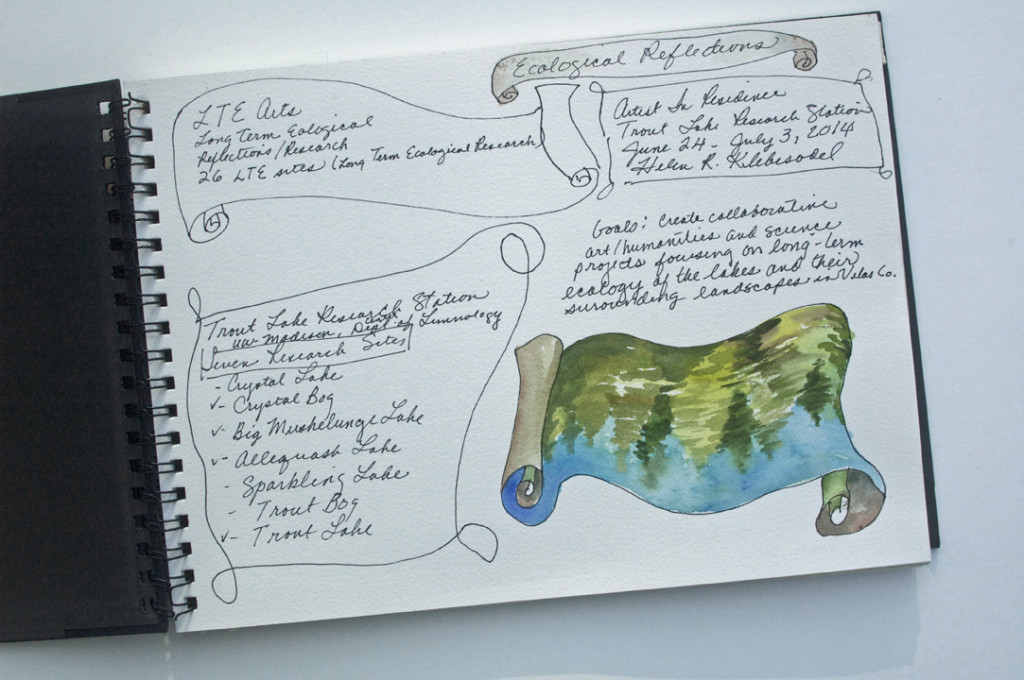

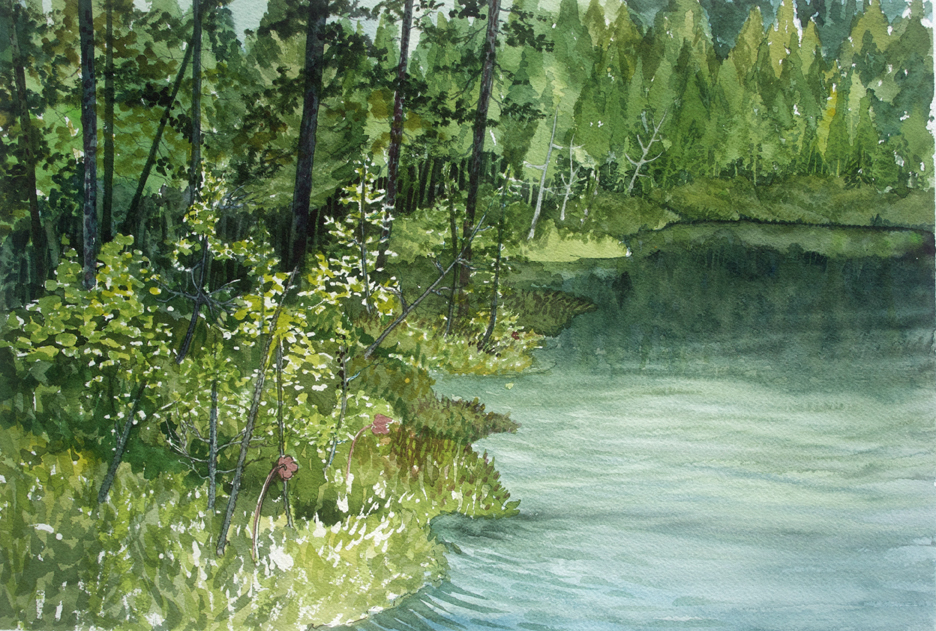


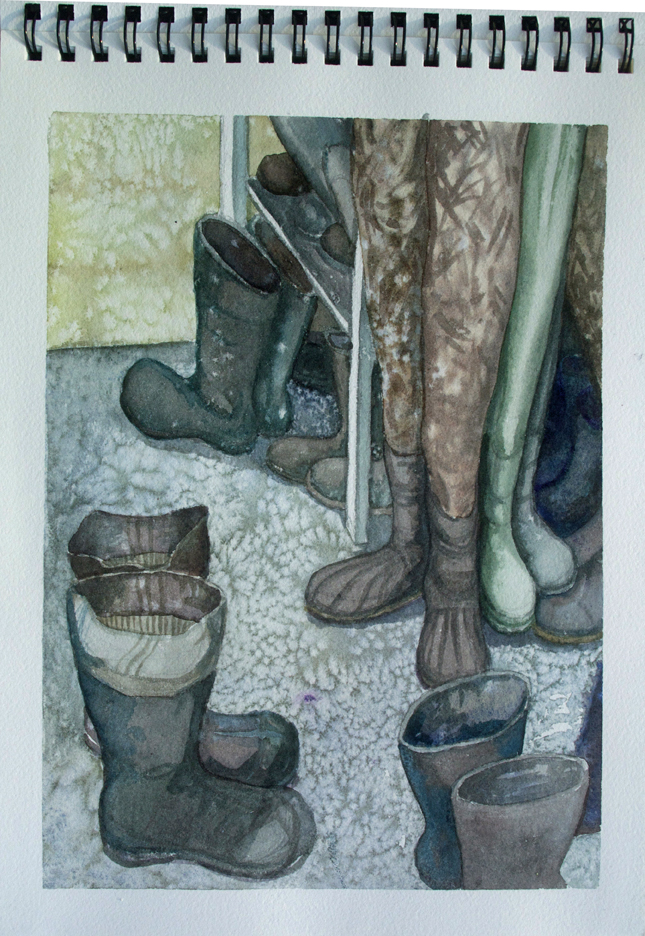
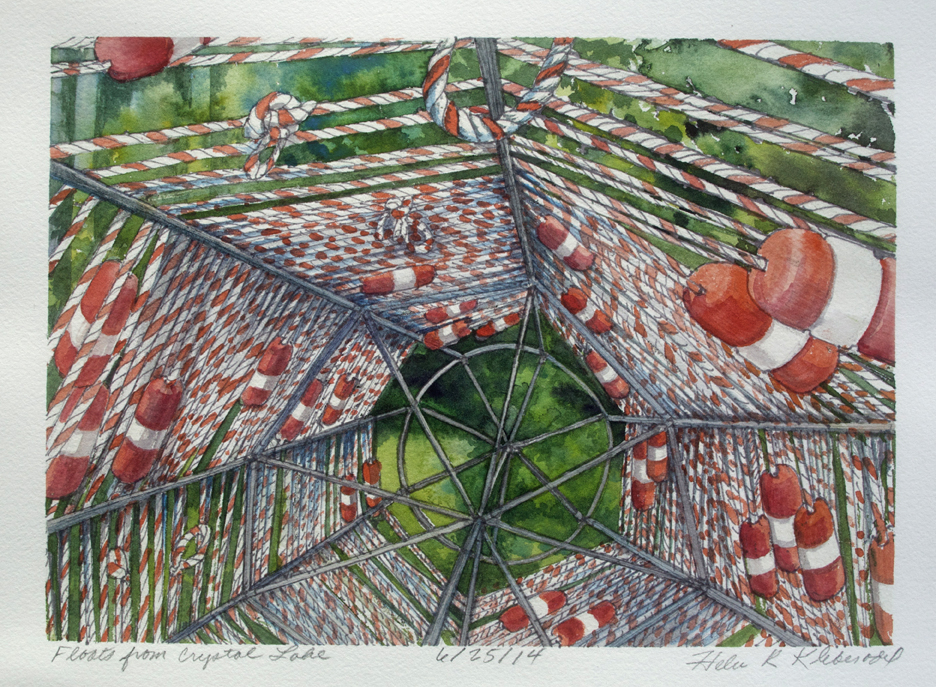



12 comments
Hi Helen, congratulations on being invited to that experience. Wonderful sketches and paintings. Maybe we’ll get to see some of them in person next summer… Love, Ken
Thanks Ken! I would love to show them to you in person next summer! Keep us on your calendar!!!!
What a delight to read and follow your adventure. Love the drawings and the watercolors. Congratulations for the artist residency which is very deserving.
Thank you Laurie.
Helen, I love thinking of you out there painting, and seeing the results! Missing you!!! Haven’t seen you for ages……
Would love to get together again sometime! Are you ever coming up as far north as Hancock?
Love, Joyce
Thanks Joyce. I’d love to see you too. Haven’t been to Hancock in a while. I’ll have to figure out something to pull me north, though your art could do it. Do you have any shows coming up?
Helen, It was such a great pleasure to see some of my favorite places rendered in your incredible paintings! I love it here at Trout Lake and I think artists like you are so valuable in showing others why this place is so special.
Thank you Carol!
Helen,
I am always astonished at the variety of places your art takes you! This sounds like a great program. Did any of the birch trees have eyes?
Hi Pamela! yes art has taken me very interesting places. I hope there is more to come. There were not as many birch trees up there since its more old growth, but the birches still look back at me when I see them. (I’m working on a new triptych of birch trees of watercolor on canvas right now.) They will always be connected to our time at Lawrence with Tim and Yumi for me. I’m headed to Door County to teach watercolor at Bjorklunden in about a week. I’ll celebrate the birches there. Lets make a date for after.
Hi Helen
It is great to see your work and this collaboration which is bringing awareness and understanding of the lake water ecology. The impact of being in this environment, with the concentration that WC requires, is reflected in the intensely rich pieces you created in the presence of this place.
Hello Helen,
I don’t know if you will ever see this comment as the last one before me was in 2014. OMG! the painting you did “Cathedral Point – Trout Lake” with the crooked pine tree in it, 30 some odd years ago when I was a kid my family would come back to Wisconsin to spend the summer camping with my grandparents. Trout lake was one of my grandpa’s favorite places to camp, I remember sitting in the crook of that crooked tree on many occasions and even have a picture of me sitting in it! Anyways it’s amazing that that tree is still there, I will be looking into buying a print of that painting on one of your websites.
Trackbacks
Your email is used for verification purposes only, it will never be shared. By submitting a comment you grant Helen R. Klebesadel a perpetual license to reproduce your words and name/web site in attribution. Inappropriate and irrelevant comments will be removed at an admin’s discretion.